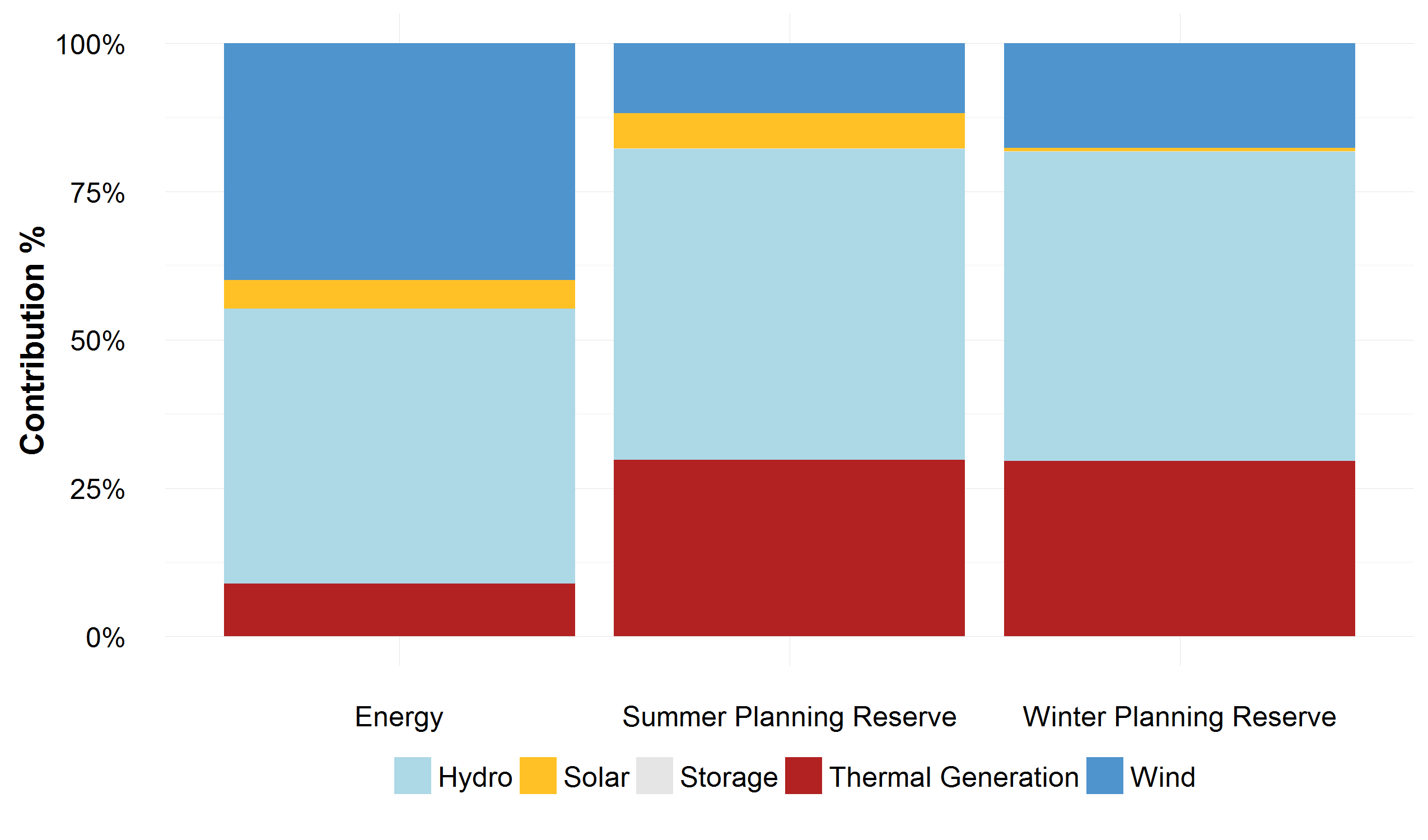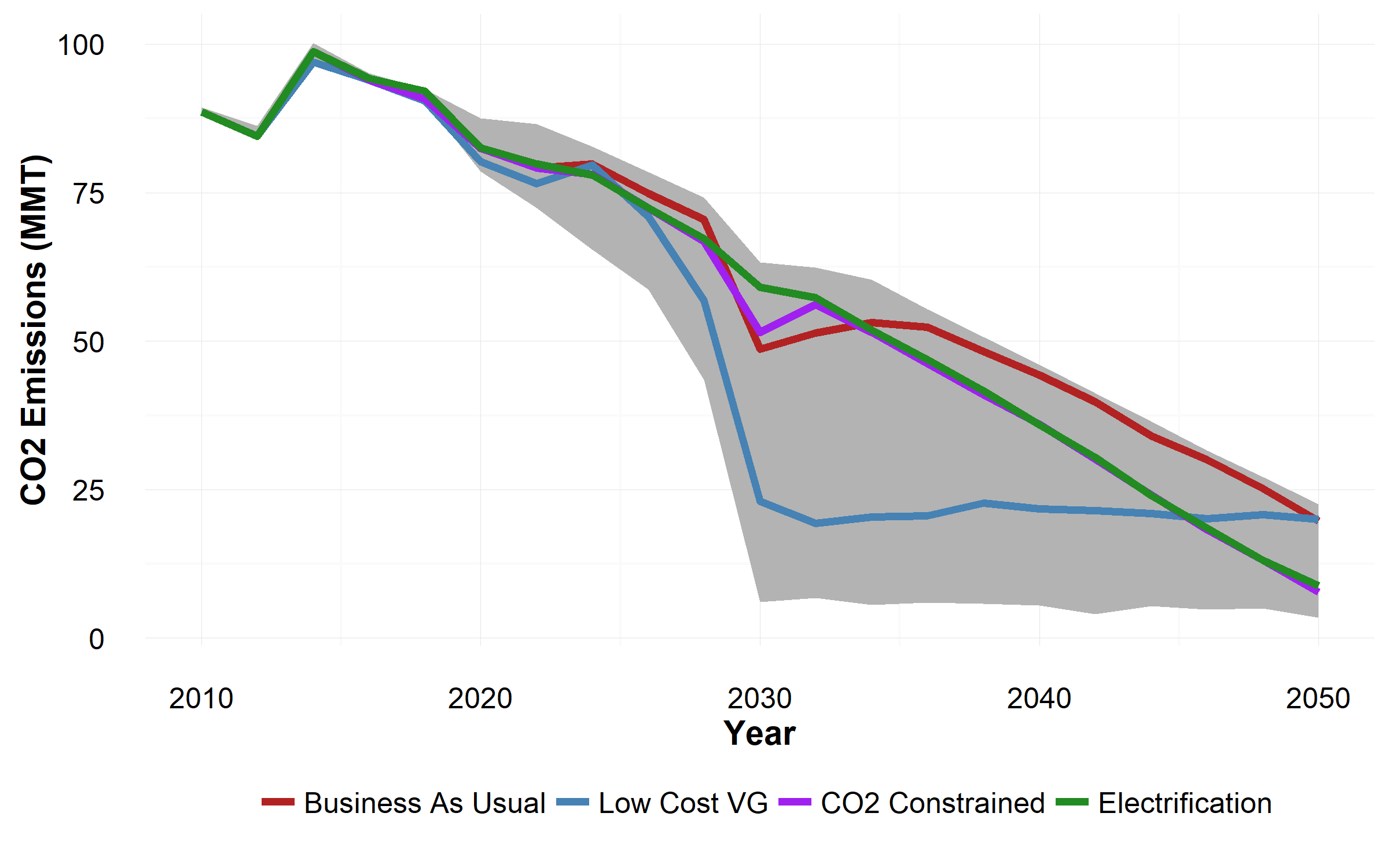North American Renewable Integration Study (NARIS) Canada Report: Summary for Policy Makers
In 2021, Canada and the United States released the North American Renewable Integration Study (NARIS or Study) Country Reports. The Study provides a long-term perspective on the optimal expansion and integration of renewable energy on the North American power grid from planning through to operation. The Study evaluates a set of policy and technology cost-driven pathways for North American grid evolution through to 2050. The outcomes of the Study also include a variety of resources for continued research and modelling, including a modelling tool for resource adequacy assessment and a public-facing results visualization interface with exportable data.
Study Overview
NARIS performs the most comprehensive long-term analysis of power system evolution to date on the North American Grid. The Study utilizes state-of-the-art analysis and modelling tools to analyze detailed power generation and transmission data down to 5-minute time resolution. NARIS applies four core scenarios for the North American power system through 2050:
- Business as usual (BAU), with limited new electricity consumption and no emissions constraints;
- Low-Cost Variable Generation, same as BAU, but using lower cost projections for variable renewable technologies;
- Carbon Constrained, where carbon emissions from the electricity sector are constrained by the model to simulate policy levers; and,
- Electrification, same as Carbon Constrained, alongside load growth consistent with the deeper electrification of heating and transportation end-uses; 2050 load nearly doubles 2020 load.
The Study also assesses 38 additional sensitivities that explore the impacts of varying assumptions such as transmission build out, level of cooperation between balancing areas, technology costs, and fuel prices.
Key Findings
A future low-carbon system can ensure resource adequacy
Results of the Study highlight that rather than requiring significant additional new forms of flexible capacity, wind and solar work together to provide approximately 20% of capacity to meet resource adequacy needs in both winter and summer across all scenarios. All generation types contribute to resource adequacy, where distributed generation plays an important role in some regions. Canada’s rich hydropower capacity and existing natural gas fleet contributes significantly to adequacy and flexibility in these scenarios.
Canadian contribution of different technologies to energy and planning reserves in Low Cost Variable Generation scenario, 2050

Text version
A bar graph presents the Canadian contribution of different technologies to energy and planning reserves in the Low Cost Variable Generation Scenario.
- In this scenario, wind and hydro provide the majority of energy, followed by thermal generation and solar, respectively.
- Summer planning reserve is largely provided by hydro and thermal generation, followed by wind and solar, respectively
- Winter planning reserve is mostly provided by hydro, wind, and thermal generation, respectively, with a small percentage of solar.
International and inter-regional transmission play a critical role in minimizing costs and emissions
NARIS results highlight that inter-regional transmission expansion can achieve up to USD $180 billion in net benefits over the 30 year Study period and that Canada can increase electricity exports. Increased electrification and renewable contribution resulted in higher transmission benefits as transmission enhances resource adequacy during both normal conditions and extreme events in these scenarios.
In all cases, the most cost-effective system resulted in significant emissions reductions
The NARIS results highlight multiple pathways that can lead to decarbonisation of 93% to 97% of Canadian generation by 2050. Each scenario in the Study achieves emissions reduction targets through differing optimal pathways. In looking at Canadian system planning, technology cost reductions realized since the Study’s inception could drive emissions down even more quickly. Additionally, NARIS results demonstrate that electricity sector emissions can be significantly reduced while maintaining resource adequacy.
Projected Canadian Power Sector annual CO2 emissions trajectory through 2050 in the core scenarios

Text version
A line graph shows the emissions trajectory through 2050 in core scenarios. All four scenario trajectories experience reductions through 2050, where the scenarios “CO2 constrained” and “electrification” experience consistent reductions, and the business as usual scenario has less emission reductions. The scenario “Low Cost Variable Generation” has the most significant emission reductions by 2030; however, emission reductions level off as of 2030. A shaded region represents the envelope of all NARIS scenarios.
Policy Implications
Policy Implication 1: To promote emissions reductions, regulators and provincial governments must incentivize utilities to consider more aggressive scenarios with high contributions of variable renewables, and consider these within integrated resource planning to ensure the lowest cost system.
Policy Implication 2: Given existing hydroelectric capacity and the contribution of wind and solar to resource adequacy needs, system balance could be maintained with a small decrease in total thermal generation capacity, and substantial decrease in annual thermal generation. Some flexible capacity is likely required to maintain resource adequacy (e.g., for peaking purposes), however low annual generation from these resources ensures associated emissions are minimal.
Policy Implication 3: To achieve least cost carbon reductions, greater inter-provincial and international coordination on transmissions system development is critical.
Summary of Research Needs
Since the inception of this Study, Canada has set more ambitious emission reductions goals, has made progress towards electrification analysis, and technology has advanced. This presents strong opportunities for future studies to build on this Study and to support Canada’s net-zero and electrification goals, including:
- Modelling the impact of advanced technologies and emissions reductions goals – studying scenarios reflecting current emission reduction targets to understand impacts of evolving technologies and operating practices.
- Research on electricity market design – to help understand how different market structures influence technology mix.
- Advanced electrification scenarios – to help understand increased electrification pathways and demand scenarios optimal mechanisms.
Conclusions
The notable findings of the NARIS study highlight important considerations for Canada’s electricity system transformation, including:
- Deeper end-use electrification is economic and possible without increased grid emissions;
- Resource adequacy can be maintained with high contributions of variable generation; and,
- Interties and increased transmission deliver long-term economic and system-wide benefits.
NARIS results demonstrate that ambitious electricity sector decarbonisation strategies are achievable. As identified in the analysis, exceeding a 92% emissions reduction level from 2005 on a shorter time scale than 2050 is likely achievable while ensuring system adequacy, affordability, and sustainability, and is worthy of further analysis. NARIS results did not find anything that would preclude more aggressive decarbonisation targets.
Policy insights support the further study and development of electrification, renewables with enabling ancillary services, and inter-regional and intra-continental transmission and trade. Enabling increased transmission and trade with the United States provides valuable opportunities for meeting shared clean energy goals. Cooperation is essential for cost-effectiveness, adequacy, and balancing of decarbonized energy system pathways.
Policy developments and technologies, which have advanced since the inception of this Study, could further enhance the cost-effectiveness of meeting economy-wide emission reduction goals through the electricity system. Future work should consider continued emphasis on innovation in policies, regulations, and markets to support and enable these NARIS results
Page details
- Date modified: